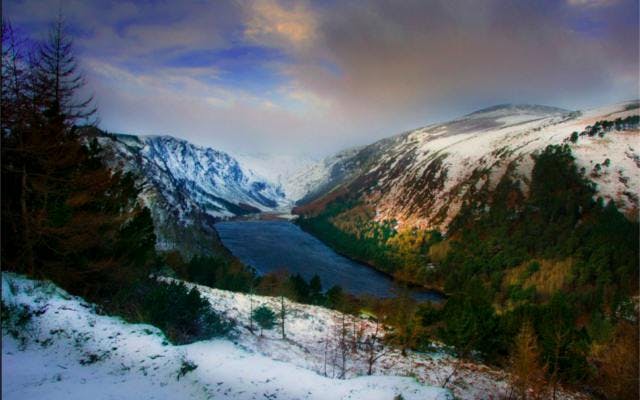
The Secrets of Glendalough
Glendalough is a truly special place, where nature, history and some amazing distilled spirits come together to form a gin-lover’s paradise. Here we discover what makes this valley - the home of January's Wild Botanical Gin - so special.
Before St Kevin discovered the valley of Glendalough, it was nothing more than a particularly spectacular patch of wilderness. But with the arrival of this devout man – heir to an Irish throne, who cast away his family’s political aspirations and instead pursued the humble and solitary life of a monk – the valley blossomed into one of Ireland’s most important monastic communities.
Head there today and you’ll see all kinds of amazing sites, natural and man-made alike. As stories of St Kevin’s wisdom spread, people flocked to the valley to be study with him. More monks meant more buildings, and in the end seven churches would be built at the base of this beautiful valley.
St Kevin himself died in the year 618, but the community he founded would go on flourish for almost 600 years. Glendalough, the valley of seven churches, was a centre of Catholicism in Ireland until the monastery there was destroyed by the invading Normans in the year 1214.
Following the invasion, the diocese at Glendalough was combined with that in Dublin. It was the death knell of this beautiful place’s influence in the world. But the story of Glendalough wasn’t over quite yet.
Records reveal that every year on the 3rd of June – St Kevin’s feast day – raucous parties would be held in the valley far into the 19th century. These days, the visitors to Glendalough are a bit more reserved: they come to see the remains of the monastic site and wander the walking trails that zigzag across the beautiful landscape.
5 Glendalough Sites You Have To See
1. The Cross of St Kevin
A true testament to the skill of the Irish craftsmen of yore, this enormous cross is carved into a block of local granite. Legend has it that any person who can reach their arms around the cross’ widest part and close the circle with a touch of their fingertips will have all of their wishes granted.
2. The Round Tower
Towering over the valley is a round bell, which pilgrims could use to navigate towards the monastery. Monks could also climb the tower to keep an eye out for anyone coming towards the community.
3 The Glendalough Cathedral
The largest of the seven churches built at Glendalough, it took two centuries to complete this beautiful structure. It’s the largest and most imposing building in the valley, and a must-see for any visitor.
4. The Upper Lake
While the majority of the monastic ruins at Glendalough are clustered around the lower lake, it’s worth making the hike to the upper lake to see the spot where the story of St Kevin and the blackbird, which so inspired the founding friends of Glendalough, supposedly took place.
5. Glendalough Gin
The team behind Glendalough are planning something really special for their new distillery, set to open sometime over the next year. With the stunning scenery and landscape of County Wicklow around them, it's sure to be a highlight of the area.
But in the menatime, while they work on their amazing new distillery, you can still get your Glendalough fix at the local Glendalough Hotel, which stocks their spirits. If you're looking to try the gins and grab a bite to eat, you can't go wrong with Casey's Bar at the hotel, or local restaurant, The Wicklow Heather.
Humble Spirits: How distilling came to Ireland
These days we don’t tend to associate men of the church with all things bright and boozy, but back in St Kevin’s day – and for hundreds of years after his death – monks were the primary distillers of spirits and brewers of beer. By extension, Glendalough has been a centre for spirits production since the Early Middle Ages.
In fact, it was monks who brought their knowledge of distilling methods back to Ireland from their travels abroad.
As Gary from Glendalough explains: “Legend has it that Irish monks were spreading the word of God when they bumped into a group of Persians, who were distilling to make perfume. The Irish said, ‘Oh, we think we can do something with that besides rubbing it on our necks!’”
The monks’ happy discovery gave rise to poitín, the original Irish distilled spirit. It’s not hard to spot the connection between its name and pota, the Irish word for a hangover.
“It has a very colourful history,” Gary says of poitín. In the 1600s the King of England made its distillation a crime, driving production underground and putting poitín on a par with moonshine. Home distillers would set up their operations on property lines so that if caught they could dispute ownership. The quality of poitín spiralled downwards, and a few unfortunate batches even led to blindness.
In recent years, however, the Irish distilling renaissance has led to a resurgence of this unique spirit. Glendalough itself makes three varieties of poitín, all based on early recipes, and in 2015 a set of high standards were imposed on the spirits industry to ensure that all of the poitín coming out of Ireland does those early monks justice.







